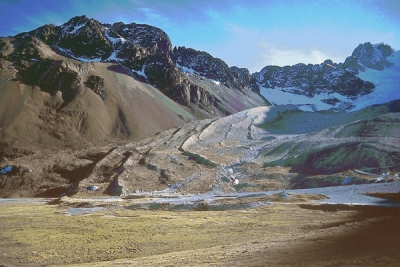A recent publication in the journal, Nature explains the success of the IRD researchers and their associates in elucidating the reasons for the glacial melt in the Andes during the last 10,000 years.
They demonstrated that the Telata Glacier in Bolivia where they performed the research has withdrawn around 3 kM in the Holocene era and will continue with that in the present. They linked the deterioration to a 3°C rise in atmospheric heat due to the heating of the Pacific Ocean and increase in solar radiation in tropics.
 Moraines (foreground, rocky deposits) provide ways of reconstituting a glacier’s history (here at Charquini). Credit: IRD
Moraines (foreground, rocky deposits) provide ways of reconstituting a glacier’s history (here at Charquini). Credit: IRD
The researchers concentrated their attention on deposits of leftovers glacier consisting of rocks, which gave evidence about the past levels of the glacier front. The abundant availability of the preserved rocks and continuous record of the subsequent stages of happening at the glaciers makes this site unique in the tropical zone.
To reconstitute the chronology of incidents to assess the changes of the glacier in the 10,000 year period, the researchers utilized the recent dating methodology. The utilized technique enabled assessing the level of chemical elements concentration, which was put up in rocks accumulated over the earth consequent to the disappearance of ice. The glaciologists employed past-climate models to assess the causes of changes in volume and changes at the Telata glacier. The results demonstrated that during the 10,000 year period the surface of the glacier has shrunk by over 90% and the ice façade retreated by 3 km. They found that though the retreat started slowly in the beginning but it speeded up from the early part of 19th century and receded 2 km in the period between 1820 and the present.
The researchers concluded that the 3°C of global warming during the last 10,000 years has resulted in the retreat of glaciers. They found that the warming of the tropical Pacific Ocean due to the gradual increase in solar radiation during the period has resulted in the receding of glaciers. The researches fear that Telata glaciers will face a strong retreat in the coming years due to the anticipated rise of about 4 to 5°C in global temperature by the year 2100.